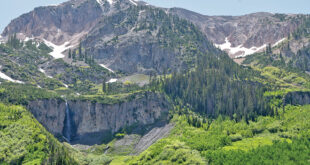There is no shortage of proposed ballot issues this election. The state’s Blue Book was not thin this year. Here are some thoughts on some of the proposals.
The no-brainers—yes and no:
Let’s start with a positive—7D is a no-brainer. Voting yes on the issue reinstates the Gunnison County Met Rec mill levy to what was originally approved by voters in 1978. In Colorado parlance, it “De-Bruces” the district from the TABOR (Taxpayer’s Bill of Rights) amendment that has basically ratcheted down the amount the Met Rec can collect over the years. Allowing the mill levy to return to one mill will permit the district to maintain its current, and deteriorating, over-the-air television service. Current revenues would not allow TV infrastructure to even be sufficiently maintained. And by keeping TV up, the transmission sites can eventually be used to help improve local telecommunications and internet service. That is a big bonus. The board has said that revenue raised beyond TV maintenance will go toward local recreational programs and projects. 7D brings opportunity, and the board has outlined a good plan on what they intend to do with the money. It opens up an array of possibilities for a small individual price, so is worth a yes vote.
What I won’t vote for is Amendment 74. 74 opens a can of worms that puts the state and every local government and thus every taxpayer—you—on the hook for any property owner who thinks a government board did something to decrease the value of their property by a nickel. It would hamstring government and make lawyers reeaaaaaally rich. A property owner wants to put a strip club next to the kindergarten and the town says no? They’d have to pay him or be ready to get sued. That is ludicrous. Voting against 74 is a no-brainer.
Proposition 109 claims it will fix highways in the state. It might fix some but at the cost of everything else the state does, including education, prisons, health care and other roads. It mandates the state borrow billions of dollars and not raise any taxes or fees to pay for that debt. So the state will have to use whatever revenue it currently collects to pay back that money over 20 years. Huh? While it specifically names 66 projects that will be addressed, the closest to us is work on Little Blue Canyon on Highway 50. 109 is just horrible economics. It is meant to starve your state government. This proposition is as bad or worse than 74. If you want to see road improvements, then vote for Proposition 110 that increases sales tax but keeps much of the revenue local and thus roadwork in the area where it was collected. It’s not perfect and it seems logical to use a gas tax to raise money for road improvements instead of a sales tax, but this is head and shoulders better than 109.
The tough calls—no, yes, and maybe:
Local ballot measure 6A is the Gunnison Valley Regional Housing Authority measure that will raise property taxes in the county for planning, financing, acquiring, constructing, reconstructing, repairing, maintaining, managing and operating housing projects or programs in Gunnison County. The ten-year, 1.5-mill property tax increase is expected to raise about $850,000 annually for affordable housing. After ten years, one mill will sunset and a half mill will remain for administrative costs.
The problem in my mind is that the Housing Authority was charged a year ago by the county commissioners to come up with a plan. A plan would then be presented to voters to explain how the tax money would be spent. That didn’t happen.
There is a solid planning effort in the works now, spearheaded by Crested Butte council member Chris Haver, Housing Authority executive director Jennifer Kermode and consultant Willa Williford, but that plan is in the early broad stages. It should be completed by the end of the year. The first review of the draft by the county commissioners happened a few weeks ago and the review started with a discussion over the controversial word “character” in the mission statement. That’s the problem right now. Those who would ultimately be in charge of the money have differing philosophies on how the money should be spent and whether or not this is even enough money to make an impact. The local politicos still haven’t figured out how to avoid conflict with Brush Creek. Affordable housing should have been a collaborative effort that brought us all together instead of the cluster of friction it has become. That’s a concern when considering this tax increase.
The Housing Authority has compiled a “pipeline” of potential projects. That’s a very basic start. The draft plan talks about an application process for developers interested in tapping into the pool of tax money. It mentions additional programs that “may be funded through use of the tax revenues” such as down payment assistance, a revolving loan program, master lease programs and educational programs, but offers no real specifics.
The other missing piece of the puzzle, not explicitly being stated, is that the Housing Authority frankly needs a co-administrator or someone with extensive affordable housing development credentials, to actually develop and coordinate affordable housing projects in the county. Current director Jennifer Kermode has the skill and background to run projects once they are going—and that is an important piece of the long-term future—but she admits that unlike her predecessor who played a big role in the development of Anthracite Place, she isn’t the one who could be considered a developer in the workforce housing arena.
Look, a plan reads something like: The first year’s initial $250,000 will go to replace uninhabitable mobile homes in Gunnison that could then be utilized for qualified workers; the second $300,000 would be used to set up a loan program to help people rehab their homes to bring down their monthly costs and make monthly costs more affordable; the next $200,000 would be used for engineering on some infrastructure costs for Gunnison’s five-acre Rock Creek parcel or toward potential housing grants; and the last $100,000 would be earmarked for the salary of a Housing Authority administrator who is an expert in developing successful public-private workforce housing projects. The second-year revenues will focus on spending the money on installing “horizontal” infrastructure on publicly owned properties that would make actual construction affordable for private contractors that would then perhaps be enticed to build workforce housing (think Brush Creek, Gunnison Rising or the Mt. Crested Butte North Village Parcel).
Or an even more simple plan: All the money collected will be allocated toward bringing down infrastructure costs or to subsidize water and sewer tap fees for deed-restricted units that will help make actual construction of actual units financially feasible.
I’m not sure either of those ideas is the best plan but they both are plans people could chew on.
Before raising property taxes that nicks everyone, including seniors and families in free-market housing trying to make it here, I want to know where Brush Creek ends up and if that sort of public-private template means the public should focus on land acquisition. I want to know what role the county’s major employers, such as the ski area and university, have in a plan. I want to see how all the local government entities implement a fee on or limit short-term vacation rentals and if the plan includes ways to bring up wages.
Given the housing situation, I understand why many people will vote for 6A in the hope it will throw money at an obvious problem to do something, anything. But it feels like a half-court jump shot at the end of the first half of a basketball game that is slipping away. I’d suggest the powers that be take the time to tighten it up, determine what funding is really useful and play good offense in the second half before the game is truly lost.
Amendment 73 is a somewhat complex income tax increase targeted to corporations, those who make decent money (more than $150,000 individually) and a property tax readjustment in terms of assessment. The tax will increase funding for preschool through 12th-grade public education and that is a worthy goal. Colorado is not perceived as an education-deficient state but it sits near the bottom of the list when it comes to the amount of money we allocate to students. That is dumb. This measure would make a significant positive impact on local schools, including the Gunnison school district where superintendent Dr. Leslie Nichols projected an additional $3.2 million annually would go to our children. Good public education is one of the hallmarks of any good community and supports a bright future. The Denver Post wrote of some valid concerns with the proposal, including unintended consequences with your residential property tax in the future and the fact that Colorado’s booming economy should add a chunk of money to schools in the state right now. I’ll vote for 73 but I too am concerned with some of the unintended consequences.
Proposition 112 requires major setbacks for new oil and natural gas development. There are already setbacks in place but this measure would require that new oil and natural gas development be located at least 2,500 feet from occupied structures, water sources, and areas designated as vulnerable. I’m for public safety and protecting water. I also like being warm. I haven’t decided on this one yet.
There are more than a half dozen other initiatives you get to vote on this year. Read the Blue Book and then mark a box. Unlike some states, it is easy to register and exercise your right as a citizen to vote in Colorado. So do it. It really does matter. You have until November 6 to get your ballot back to the county clerk.
—Mark Reaman
 The Crested Butte News Serving the Gunnison Valley since 1999
The Crested Butte News Serving the Gunnison Valley since 1999





